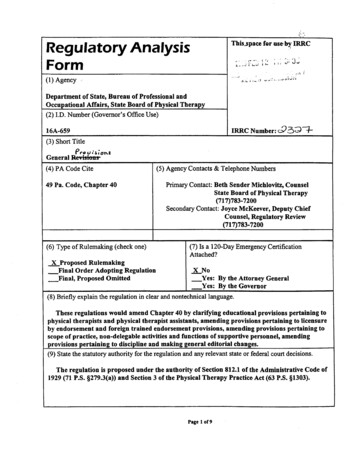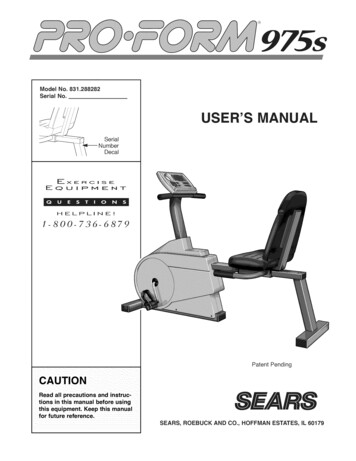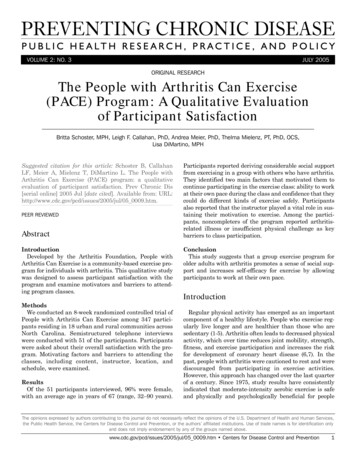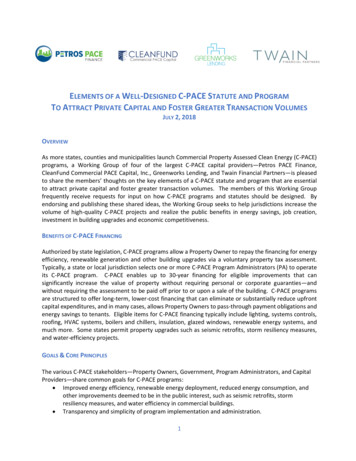
Transcription
This pace for use by IRRCRegulatory AnalysisForm(1) AgencyDepartment of State, Bureau of Professional andOccupational Affairs, State Board of Physical Therapy(2) I.D. Number (Governor's Office Use)16A-659IRRC Number: c P 2 3 / -(3) Short TitleGeneral Revisions(4) PA Code Cite49 Pa. Code, Chapter 40(6) Type of Rulemaking (check one)X Proposed RulemakingFinal Order Adopting RegulationFinal, Proposed Omitted(5) Agency Contacts & Telephone NumbersPrimary Contact: Beth Sender Michlovitz, CounselState Board of Physical Therapy(717)783-7200Secondary Contact: Joyce McKeever, Deputy ChiefCounsel, Regulatory Review(717)783-7200(7) Is a 120-Day Emergency CertificationAttached?X NoYes: By the Attorney GeneralYes: By the Governor(8) Briefly explain the regulation in clear and nontechnical language.These regulations would amend Chapter 40 by clarifying educational provisions pertaining tophysical therapists and physical therapist assistants, amending provisions pertaining to licensureby endorsement and foreign trained endorsement provisions, amending provisions pertaining toscope of practice, non-delegable activities and functions of supportive personnel, amendingprovisions pertaining to discipline and making general editorial changes.(9) State the statutory authority for the regulation and any relevant state or federal court decisions.The regulation is proposed under the authority of Section 812.1 of the Administrative Code of1929 (71 P.S. §279.3(a)) and Section 3 of the Physical Therapy Practice Act (63 P.S. §1303).Page 1 of9
Regulatory Analysis Form(10) Is the regulation mandated by any federal or state law or court order, or federal regulation? If yes,cite the specific law, case or regulation, and any deadlines for action.No.(11) Explain the compelling public interest that justifies the regulation. What is the problem itaddresses?The current regulatory provisions are outdated and do not reflect current practice. Thecurrent regulations are confusing in some respects. For example, §40.4 currently provides for thelicensure of applicants. That provision is confusing in that it doesn't specifically indicate that aforeign educated applicant meets the requirements by holding a license in the country where hereceived his education, holding a license in another state or territory of the United States or byapplying for licensure by examination. These regulations would clarify that issue.The regulations would be amended to reflect the Board's recognition of the Commission onAccreditation in Physical Therapy Education (CAPTE) as the approved accrediting program foreducational programs of physical therapy. Beginning January 1, 2002, CAPTE will accredit onlyprograms that offer a post-baccalaureate degree. There are currently 17 accredited programs inPennsylvania all of which are at the post-baccalaureate level. All physical therapy programs inPennsylvania are either already accredited by CAPTE or in the process of becoming accreditedby CAPTE. These amendments would require an applicant to have graduated from a CAPTEaccredited program within 6 months of the effective date of these regulations,(continued on Page 9)(12) State the public health, safety, environmental or general welfare risks associated withnonregulation.Nonregulation would be a risk to public health and safety in that the public would be receivingcare from physical therapists and physical therapist assistants who may not have adequateeducation and training and may not be providing care appropriate to their level of education andskill.(13) Describe who will benefit from the regulation. (Quantify the benefits as completely as possibleand approximate the number of people who will benefit.)Members of the public who receive physical therapy care will benefit from the regulations byassuring that licensees are adequately educated and provide care appropriate to their level of skilland expertise. Foreign educated applicants for licensure will benefit from these regulations bybeing provided with a more clear understanding of the educational requirements they must meetLicensees will benefit from the regulation by having regulatory provisions that more clearlyreflect modern practice.Page 2 of9
Regulatory Analysis Form(14) Describe who will be adversely affected by the regulation. (Quantify the adverse effects ascompletely as possible and approximate the number of people who will be adversely affected.)Physical therapist assistants may be adversely affected by restricting their practice. However,the Board believes that any adverse affect is outweighed by safety to the patients receivingtreatment.(15) List the persons, groups or entities that will be required to comply with the regulation.(Approximate the number of people who will be required to comply.)Physical therapists and physical therapist assistants will be required to comply with theregulation. There are 9,054 licensed physical therapists in the Commonwealth and 3,126 licensedphysical therapist assistants.(16) Describe the communications with and input from the public in the development and drafting ofthe regulation. List the persons and/or groups who were involved, if applicable.In December 1999, the Board sent draft revisions to professional associations, educationalinstitutions and interested individuals who the Board identified as being interested in regulatorymeasures and asked for public input. The Board received approximately 300 responses. TheBoard considered these responses in the final drafting of these regulations. The following is a listof all individuals, organizations, educational institutions and professional associations that werecontacted: Pennsylvania Physical Therapy Association, Hospital and Health System Associationof Pennsylvania, Pennsylvania Association of Rehabilitation Facilities, Pennsylvania AthleticTrainers Society, Beaver College, Chatham College, College Misericordia, Duquesne University,Gannon University, Medical College of Pennsylvania and Hahnemann University, PhiladelphiaCollege of Pharmacy and Science, Slippery Rock University, Temple University, ThomasJefferson University, University of Pittsburgh, University of Scranton, Alvernia College, CentralPennsylvania Business School, Community College of Allegheny County Boyce Campus, HarcumCollege, Lehigh Carbon Community College, Medical College of Pennsylvania & HahnemannUniversity, Mercyhurst College, Mount Aloysius College, Penn State University, Penn StateUniversity Mont Alto Campus, East Stroudsburg University, Lock Haven University,Pennsylvania State University, California University of Pennsylvania, University of Pittsburgh,Slippery Rock University, West Chester University, Temple University, Messiah College,Waynesburg College, and Mercyhurst College.(17) Provide a specific estimate of the costs and/or savings to the regulated community associated withcompliance, including any legal, accounting or consulting procedures which may be required.There will be no costs and/or savings to the regulated community.Page 3 of9
Regulatory Analysis Form(18) Provide a specific estimate of the costs and/or savings to local governments associated withcompliance, including any legal, accounting or consulting procedures which may be required.The regulation will not result in costs and/or savings to local government(19) Provide a specific estimate of the costs and/or savings to state government associated with theimplementation of the regulation, including any legal, accounting, or consulting procedures which maybe required.The regulation will not result in costs and/or savings to state government.Page 4 of9
Regulatory Analysis Form(20) In the table below, provide an estimate of the fiscal savings and costs associated withimplementation and compliance for the regulated community, local government, and state governmentfor the current year and five subsequent years.Current FYYearSAVINGS:Regulated CommunityFY 1YearFY 2YearFY 3YearFY 4YearFY N/AN/AN/ALocal GovernmentState GovernmentTotal SavingsCOSTS:Regulated CommunityLocal GovernmentState GovernmentTotal CostsREVENUERegulated CommunityLocal GovernmentState GovernmentTotal Revenue(20a) Explain how the cost estimates listed above were derived.N/APage 5 of9
Regulatory Analysis Form(20b) Provide the past three year expenditure history for programs affected by the regulation.ProgramState Board ofPhysical TherapyFY-3FY-2FY-1 239,918.62 268,110.98 259,949.13Current FY 262,000(21) Using the cost-benefit information provided above, explain how the benefits of the regulationoutweigh the adverse effects and costs.N/A(22) Describe the nonregulatory alternatives considered and the costs associated with those alternatives.Provide the reasons for their dismissal.Nonregulatory alternatives were not considered because the only way to update and clarify thepertinent regulatory provisions is through regulations*(23) Describe alternative regulatory schemes considered and the costs associated with those schemes.Provide the reasons for their dismissal.N/APage 6 of 9
Regulatory Analysis Form(24) Are there any provisions that are more stringent than federal standards? If yes, identify thespecific provisions and the compelling Pennsylvania interest that demands stronger regulation.N/A(25) How does this regulation compare with those of other states? Will the regulation put Pennsylvaniaat a competitive disadvantage with other states?In drafting these regulations, the Board used national models for physical therapy assistanteducation and guidelines issued by the Federation of State Boards of Physical Therapy.Therefore, these regulations are in accordance with the practice of other state boards of physicaltherapy, including those in all the states contiguous to Pennsylvania, and will not putPennsylvania at a competitive disadvantage with other states.(26) Will the regulation affect existing or proposed regulations of the promulgating agency or otherstate agencies? If yes, explain and provide specific citations.No.(27) Will any public hearings or informational meetings be scheduled? Please provide the dates, times,and locations, if available.The Board has already entertained comments from the public on draft regulations. No furtherpublic hearings or informational meetings are scheduled. The Board is continually discussing theserevisions at regularly scheduled Board meetings held bi-monthly at 124 Pine Street in Harrisburg,PA, The Board holds bi-monthly public meetings at which information relative to all rulemakingis discussed. Meetings are held in the Board's offices at 116-124 Pine Street, Harrisburg,Pennsylvania. A schedule of Board meeting dates is available on the Department of State's website atwww.dos.state.pa.us/bpoa.Page 7 of9
Regulatory Analysis Form(28) Will the regulation change existing reporting, record keeping, or other paperwork requirements?Describe the changes and attach copies of forms or reports which will be required as a result ofimplementation, if available.No.(29) Please list any special provisions which have been developed to meet the particular needs ofaffected groups or persons including, but not limited to, minorities, elderly, small businesses, andfarmers.Because the Board has determined no special needs of any subset or group, no specialprovisions have been developed to meet particular needs of affected groups or persons.(30) What is the anticipated effective date of the regulation; the date by which compliance with theregulation will be required; and the date by which any required permits, licenses or other approvalsmust be obtained?The regulation will be effective upon publication of Final Rulemaking in the PennsylvaniaBulletin. Compliance will be required as of that date.(31) Provide the schedule for continual review of the regulation.The Board continuously reviews its regulations, periodically communicates with licenseesthrough newsletters and obtains information and feedback from its licensees on a frequent basis.Page 8 of9
(11) continued:There is a compelling public interest in establishing the professional education required for foreigntrained physical therapists who wish to obtain a license in this Commonwealth. Currently, theregulations do not set forth the specific professional education that the Board believes is necessary toestablish competency. Foreign educated applicants have had a difficult time complying with theBoard's current regulations because it is conditional upon securing a credentials evaluation for alleducational requirements. These regulations would explicitly establish the precise professionaleducational requirements that the Board expects an applicant to have.There is also a compelling public interest in assuring that the Board's regulations reflect currentpractice. Accordingly, the Board has proposed regulations permitting physical therapists to performtransdermal administration of over-the-counter and prescriptive drugs and administeringelectroneuromyography (EMG) and nerve conduction velocity tests (NCV) upon the referral of aphysician. These regulations also serve the public interest by specifying that the failure to maintainadequate patient records constitutes unprofessional conduct.These regulations also promote public safety by specifically stating that a physical therapist maydelegate to a physical therapist assistant or supportive personnel that which he or she is educated toperform. It would also clarify that mobilization is not a procedure that a physical therapist would bepermitted to assign or delegate to a physical therapist assistant or supportive personnel. The Boardbelieves that public safety dictates that only physical therapists can perform this procedure.Mobilization would be defined as a passive therapeutic movement at any point in the range of motionat variable amplitudes and speeds. Mobilization does not include gross passive movement throughoutnormal planes of joint motion. In addition, it is critical to patient safety that when patient careservices are provided by the physical therapist assistant, the physical therapist reevaluate and adjustthe plan of care at intervals not to exceed fourteen days.The regulations would also prohibit the delegation to physical therapist assistants or supportivepersonnel, personnel screenings to determine the need for the following: 1) primary, secondary ortertiary services; 2) further examination or intervention; 3) consultation by a physical therapist; 4)referral to another health care practitioner. Screening would be defined as determining the need forfurther examination and/or intervention by a physical therapist or for referral to another healthprofessional. The Board believes these restrictions are critical to safe patient care.Page 9 of9
CDL-1FACE SHEETFOR FILING DOCUMENTSWITH THE LEGISLATIVE REFERENCE BUREAU" - i 2(Pursuant to Commonwealth Documents Law)K4 c23P7Copy below is hereby- approved as toform and legality. Attorney GeneralS4ms- ' i-jr ; *U:J '' ' i jjfjDO NOT WRITE IN THIS SPACECopy below is hereby certified to be a true and correctcopy of a document issued, prescribed or promulgated by:Copy below is approved asto form and legality.Executive or IndependentState Board of Physical Therapy(AGENCY)DOCUMENT/FISCAL NOTE NO.DATE OF ADOPTION:16A*-659 //?i/t'O2 DATE OF APPROVALDATE OF APPROVALBY:(Deputy General Counsel(lihlfel "re ipf»«»T—Independent Agency(Strike inapplicabletitle)Chairperson(EXECUTIVE OFFICER, CHAIRMAN OR SECRETARY)[]Check if applicableCopy not approved.Objections attached.[ 3 Check ifapplicable. No AttorneyGeneral approval orobjection within 30 dayafter submission.PROPOSED RULEMAKINGCOMMONWEALTH OF PENNSYLVANIADEPARTMENT OF STATEBUREAU OF PROFESSIONAL AND OCCUPATIONAL AFFAIRSSTATE BOARD OF PHYSICAL THERAPY49 PA. CODE, CHAPTER 40GENERAL REVISIONS
General Provisions16A-659April 2,2002The State Board of Physical Therapy (Board) proposes to amend its regulations at 49 Pa.Code, Chapter 40 by amending the following sections: 40.1, 40.4, 40.11, 40.14, 40.15, 40.16,40.17, 40.18, 40.21, 40.22, 40.23, 40.24, 40.32, 40.51, 40.52, 40.53, 40.81, 40.161, 40.163 and40.164. The Board's amendments include educational and licensure provisions pertaining tophysical therapists and physical therapist assistants, scope of practice provisions, non-delegableactivities and functions of supportive personnel and provisions pertaining to discipline. TheBoard also proposes to make general editorial amendments.Effective DateThe amendments will be effective upon publication of final form regulations in thePennsylvania Bulletin.Statutory AuthorityThe amendments are authorized under Section 3 of the Physical Therapy Practice Act(Act), (63 P.S. §1303), as well as Section 812.1 of the Administrative Code of 1929 (71 P.S.§279.3(a)).Background and PurposeMost of the Board's regulations have not been amended since the mid-1980s. Many ofthe Board's current provisions are unnecessary or require clarification. With respect toeducational requirements for physical therapists, the regulations need to be updated and refined.Provisions pertaining to the scope of practice of a physical therapist should be updated. TheBoard also intends to refine and clarify non-delegable activities which may not be assigned to aphysical therapist assistant or supportive personnel. The following is a description of theproposed amendments.Description of Proposed AmendmentsSection 40.4(2) would be amended by clarifying that the Board issues licenses byendorsement to applicants who are educated in another state or territory of the United States.Subsection (4) would be amended by updating the word "trained" to "educated" which is a moreaccurate term of art. The Board proposes to add subsection (5) to this section to make it clearthat the Board also issues licenses by endorsement to applicants educated in a foreign countryand who are authorized to practice as a physical therapist without limitations in the countrywhere the professional education occurred and who hold a valid license by examination inanother state or territory of the United States providing that the requirements were, at the time ofreceiving the license, substantially equivalent to the requirements set forth in the act. Althoughthe board has always issued such licenses, the regulations did not clearly state that the license byendorsement pertained to a foreign educated applicant who also holds a valid license byexamination in another state or territory of the United States.
General Provisions16A-659April 2,2002Section 40.11 pertaining to license by examination would be amended at subsection (1) toreflect the Board's recognition of the Commission on Accreditation in Physical TherapyEducation (CAPTE) as the approved accrediting program for educational programs of physicaltherapy. One of the more rapid changes that is occurring in physical therapy education is themove toward the entry level doctorate in physical therapy (DPT). Beginning January 1, 2002,CAPTE will accredit only programs that offer a post-baccalaureate degree. There are currently17 accredited programs in Pennsylvania, all of which are at the post-baccalaureate level. Allphysical therapy programs in Pennsylvania are either already accredited by CAPTE or in theprocess of becoming accredited by CAPTE. Section 40.11(1) would require an applicant to havegraduated from a CAPTE accredited program within 6 months of the effective date of theseregulations. Subsection (2) of that section would be amended to clarify that the baccalaureatedegree consists of at least 120 semester hours.Sections 40.15(c) and (d) would be deleted by this proposal because the Board hasswitched from paper and pencil examinations to computer based testing, which is available on afrequent basis.Section 40.16, pertaining to licensure by endorsement, would be amended by clarifyingthat subsection (a) applies to applicants who were educated in a state or territory of the UnitedStates and that subsection (b) applies to applicants who were educated in a country or territoryoutside of the United States. Subparagraph (a)(2) would be deleted because subparagraph (1)already states that the requirements for licensure or regulation in the state from which theapplicant was originally licensed must be substantially equal to the requirements for licensure inthis Commonwealth. Also, the passing scores for examinations are uniform throughout theUnited States since the examination is national.Subsection (b) is added regarding licensure by endorsement for an applicant who wastrained in a foreign country. This provision more clearly sets out the requirements for suchapplicants. The applicant would be required to meet the educational requirements set forth inSection 40.17 pertaining to foreign educated physical therapists applying to take the licensureexamination. If the applicant is licensed in a country or territory outside of the United States, theapplicant would also be required to submit evidence that the applicant holds that license withoutrestriction. The applicant must also hold a valid license by examination in another state orterritory of the United States providing the requirements were, at the time of receiving thelicense, substantially equivalent to the requirements set forth in this act.The requirements of Section 40.17 would be amended by requiring the foreign trainedapplicant to provide evidence that the school of physical therapy where the education occurred isrecognized by its own ministry of education, or other authorizing agency or entity, and if theapplicant is licensed in the foreign country where he was educated, he must provide proof ofauthorization to practice in the country where the professional education took place. Theapplicant must also provide proof of legal authorization to seek employment in the United Statesor its territories. The Board believes this is necessary to protect the health and safety of theCommonwealth's citizens from licensing illegal aliens. Subsection (5) would amend theeducational requirements for foreign trained applicants by referring to general educational
General Provisions16A-659April 2,2002requirements. The applicant would be required to complete 50, rather than 60, credit hours ingeneral education subjects including a minimum of ten credit hours in electives rather than 20hours. Subsection (6) would be added to establish professional education of 60 credit hours forforeign trained applicants applying to take the licensure examination. These requirements weredeveloped through the use of guidelines set forth by the Federation of State Boards of PhysicalTherapy.The Board proposes to delete Section 40.18 pertaining to approved physical therapyschools since the Board sets out previously at Section 40.11(1) that an approved school is onethat is accredited by the Commission on Accreditation in Physical Therapy Education (CAPTE).Section 40.21 would be deleted because licenses issued through the endorsement processare processed quickly obviating the necessity of issuing temporary licenses. This pertains todeleting Sections 40.23 and 40.24 as well. In addition, with respect to Section 40.24, relating toexpiration of temporary licenses, the statute does not authorize the Board to renew a temporarypermit.Section 40.22 would be amended by clarifying that a physical therapist holding atemporary license works under the on-premises supervision of a licensed physical therapist withat least two years of experience. This reflects Section 6(g) of the Act (63 P.S. §1306(g))pertaining to temporary licenses. Section 6(g) of the Act also states that a temporary licenseexpires upon the failure of the first examination or six months after the date of issue, whicheveroccurs first. Section 40.22(b) of this proposal reflects that statutory provision.Scope of Practice of Physical Therapists, Supportive Personnel and Physical Therapist Assistants- Sections 40.32. 40.51, 40.53.Section 40.32 (concerning functions of supportive personnel) would be amended topermit supportive personnel to record the care given to a patient through the use of flow chartsand checklists which identify the care or services provided. The Board developed this provisionbased upon guidelines for physical therapy documentation published by the American PhysicalTherapy Association.Section 40.51 would be amended regarding the physical therapist's scope of practice. Inparticular, current subsection (a) would be deleted and restated at new subsection (a). A newsubsection (b) would be added which would authorize a physical therapist to performtransdermal administration of drugs through the use of modalities such as ultrasound andelectrical stimulation. The Board has always considered this procedure to be within the scope ofpractice of a physical therapist. Licensees have questioned the Board on the procedures thatphysical therapists should follow when administering drugs transdermally (i.e. iontophoresousand phonophoresous). Accordingly, this provision clarifies and reflects current practice. Theprovision requires that if a prescriptive medication is used, such medication must be prescribedby the referring physician and dispensed in the name of the patient by the referring physician orpharmacist. The remaining medications must be disposed of by the physical therapist or returned
General Provisions16A-659April 2,2002to the patient. Drugs must be properly stored in a manner consistent with pharmaceuticalpractice.Section 40.53 (regarding non-delegable activities) would be amended at subsection (a) tostate the general rule that a physical therapist may delegate to a physical therapist assistant orsupportive personnel that which he or she is educated to perform. Subsection (b)(7) would beamended to clarify that mobilization is not a procedure that a physical therapist would bepermitted to assign or delegate to a physical therapist assistant or supportive personnel.Mobilization would be defined as a passive therapeutic movement at any point in the range ofmotion at variable amplitudes and speeds. The purpose of joint mobilization is to restoreaccessory joint movements. Mobilization does not include gross passive movement throughoutnormal planes of joint motions. A physical therapist may still delegate to a physical therapistassistant gross passive movement throughout normal planes of joint motions. The Board doesnot intend to prohibit a physical therapist from delegating to a physical therapist assistant theperformance of range of motion or the performance of exercises to restore the functional motionof the joint. Joint mobilization is used to restore accessory joint motion (i.e., gliding of jointsurfaces).Subsection (d) would be amended to require a physical therapist to reevaluate and adjusta patient's plan of care at intervals not to exceed 14 days rather than 30 days where that plan ofcare is provided by the physical therapist assistant. The Board recognizes that conditions ofpatients can change in less than 30 days and that only the physical therapist is authorized toevaluate and change the patient's plan of care. Accordingly, the Board believes this changewould result in more effective and safer practice.Subsection (e) would be added to assure that physical therapists not assign or delegate tophysical therapist assistants or supportive personnel the performance of consultations, initialevaluations, reevaluations or discharge summaries and the interpretation of the resulting datacollected since these procedures require the skill and expertise of a license physical therapist.Subsection (f) would prohibit a physical therapist from assigning or delegating to aphysical therapist assistant or supportive personnel screenings to determine the need for thefollowing: (1) primary, secondary or tertiary services; (2) further examination or intervention;(3) consultation by a physical therapist; (4) referral to another health care practitioner. Forpurposes of this section, screening would be defined as determining the need for furtherexamination and/or intervention by a physical therapist or for referral to another healthprofessional. The procedures outlined in subsection (f) pertaining to screening require the skilland knowledge of a physical therapist to evaluate the need for further intervention by a physicaltherapist. A physical therapist cannot delegate the evaluation of a patient to a physical therapistassistant or supportive personnel. The Board has received numerous requests to clarify thisissue.
General Provisions16A-659April 2,2002Registration of Physical Therapist Assistants, and Examination of Physical Therapist Assistants- Sections 40.161. 40.163 and 40.164.Sections 40.161 and 40.163 (pertaining to physical therapist assistants) would beamended by deleting the reference to nationally recognized accrediting agency and includinginstead the Commission on Accreditation in Physical Therapy Education (CAPTE). CAPTE iscurrently the only accrediting body for physical therapy educational programs.Section 40.164 pertaining to physical therapist assistant registration examination wouldbe amended by deleting Subsections (b) and (d). Subsection (b) would be deleted because thepassing score is set by the third party testing service. Subsection (d) is deleted because otherprovisions of these regulations establish that applicants by endorsement must pass an examequivalent to that required in the Commonwealth. Accordingly, this provision is unnecessary.Unprofessional Conduct of Physical Therapists - Section 40.52.Section 40.52 (pertaining to unprofessional conduct of physical therapists) would beamended at subsection (12) to make it unprofessional for a physical therapist to fail to maintainadequate patient records. Adequate patient records would include at a minimum a summary ofthe findings of the examination, an evaluation, a diagnosis, the plan of care including desiredoutcomes, the treatment record,
Occupational Affairs, State Board of Physical Therapy (2) I.D. Number (Governor's Office Use) 16A-659 This pace for use by IRRC IRRC Number: cP2 3 /- . Trainers Society, Beaver College, Chatham College, College Misericordia, Duquesne University, Gannon University, Medical College of Pennsylvania and Hahnemann University, Philadelphia .











